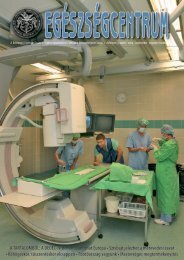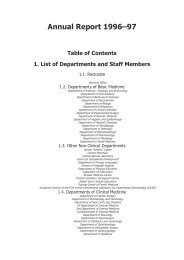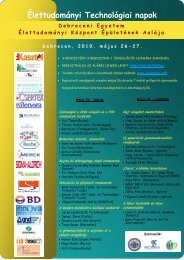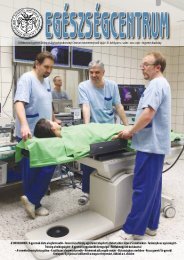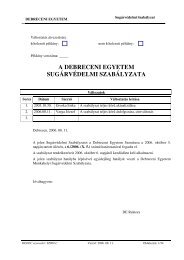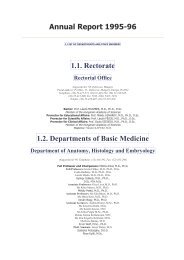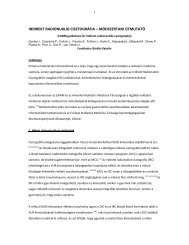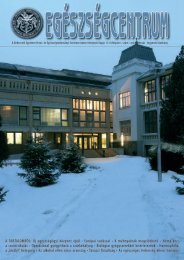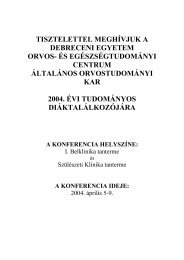Programfüzet (PDF) - DE OEC Tudományos Diákköri Tanács
Programfüzet (PDF) - DE OEC Tudományos Diákköri Tanács
Programfüzet (PDF) - DE OEC Tudományos Diákköri Tanács
Create successful ePaper yourself
Turn your PDF publications into a flip-book with our unique Google optimized e-Paper software.
G1.3. Dinshaw, Leon Gen.Med. III., Herceg Mónika ÁOK IV.Biofizikai és Sejtbiológiai IntézetIMPROVEMENT OF THE ION CHANNEL SELECTIVITY OF ASCORPION TOXIN BY POINT MUTATIONSThe voltage-gated Kv1.3 channel plays a key role in the activation of Tlymphocytes by maintaining a negative membrane potential. By blocking thesechannels the proliferation of T cells can be inhibited. This can result inimmunosuppression which has a great potential in the therapy of certainautoimmune diseases.Anuroctoxin, which is a peptide of 35 amino acids isolated and characterizedpreviously by our workgroup from the venom of the scorpion Anuroctonusphaiodactylus blocks the Kv1.3 channel with high affinity. The dissociationconstant of the block is 0.7 nM. Although with lower affinity, the toxin alsoblocks another K+ channel, Kv1.2 (Kd = 6 nM). Kv1.2 channels are localized inthe membrane of neurons, heart and smooth muscle cells, thus this property ofthe toxin is not advantageous considering its potential clinical use.In this study we examined four variants of anuroctoxin produced by chemicalsynthesis. Besides the wild-type toxin we tested three mutant toxins each with apoint mutation in its amino acid sequence based on the comparison of thepublished sequences of toxins selective for Kv1.2 or Kv1.3. Our expectationwas that the mutations would improve the selectivity of the toxin for Kv1.3 overKv1.2.We investigated the effect of the toxins with whole-cell patch-clamp techniqueon activated T lymphocytes endogenously expressing Kv1.3 channels and HEK-TSA cells transfected with the gene of the Kv1.2 channel. We obtained doseresponsecurves for each toxin that demonstrated any blocking effect on bothKv1.2 and Kv1.3 channels to determine their dissociation constants.Although the mutant toxins’ affinity was slightly decreased for Kv1.3 comparedto the wild-type, the change was much more pronounced in the case of Kv1.2.The mutants practically lost affinity for Kv1.2 as we could not detect significantblocking effect even at very high concentrations (100 nM). Thus, the mutationsfulfilled our expectations, since all mutants dramatically increasedanuroctoxin’s selectivity for Kv1.3 over Kv1.2. These results provide thefoundation for the possibility of the production and future therapeuticapplication of additional, even more selective toxins.Témavezet: Dr. Panyi György, Dr. Varga Zoltán72





